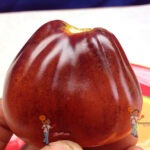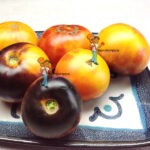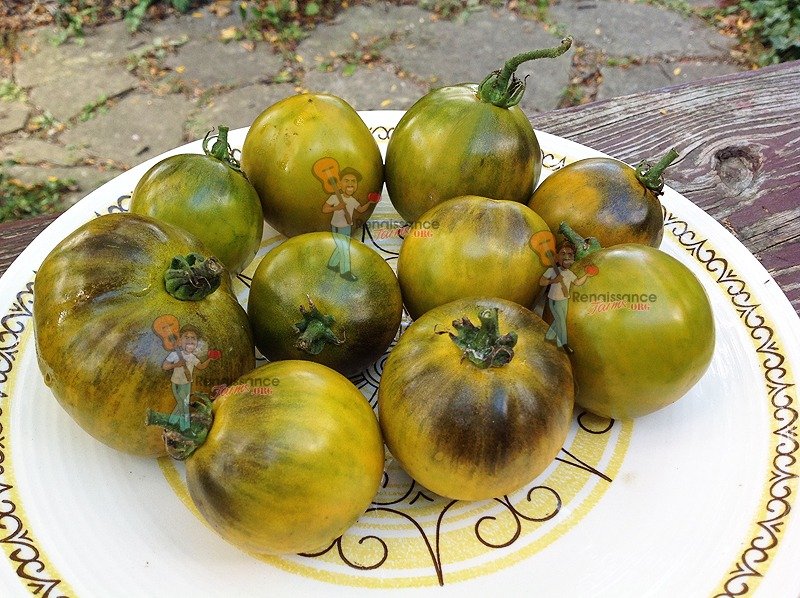Some Facts About Antho Tomatoes
For the better part of the last ten years, the popularity of Antho tomatoes have been on the rise. As a tomato grower, I must say that I am still intrigued by them. I am also fascinated by the wide array of shapes, size, taste and individual coloration display of anthocyanin varieties. Elated and optimistic would be great words to describe how I feel about the emergence of anto varieties. So I have decided to share some facts about antho tomatoes which I have noticed since I’ve been growing them.
Some Misconceptions About Anthocyanin Tomatoes
 Like non-antho varieties, antho tomatoes have their strengths and weaknesses. One constant thing that I have heard from some fanciers, is that antho varieties do not have that full flavored tomato taste that’s so desired in a good tomato. In my experience, this is not at all true. Although I have not found many anthos that have superb flavor, Blue Pear, Black Beauty, Great White Blues and a some others are very good tasting tomatoes and definitely worth growing. I especially love Tar Tops, which has an excellent, tangy and sweet flavor! In fact, I do offer some anthos as fruits for my market sales, year after year, and also as seeds on my website. They encourage many return customers. As a rule, I do not offer any seeds for which I have found their parent variety undesirable!
Like non-antho varieties, antho tomatoes have their strengths and weaknesses. One constant thing that I have heard from some fanciers, is that antho varieties do not have that full flavored tomato taste that’s so desired in a good tomato. In my experience, this is not at all true. Although I have not found many anthos that have superb flavor, Blue Pear, Black Beauty, Great White Blues and a some others are very good tasting tomatoes and definitely worth growing. I especially love Tar Tops, which has an excellent, tangy and sweet flavor! In fact, I do offer some anthos as fruits for my market sales, year after year, and also as seeds on my website. They encourage many return customers. As a rule, I do not offer any seeds for which I have found their parent variety undesirable!
Antho Tomatoes – Dark, Darker, Darkest.
One misconception that many people have is that all antho tomatoes are excessively dark. Some anthocyanin tomatoes are very dark, to the point where they actually look totally black. Others are medium dark, while a few varieties look like that are not even in the antho family. Sometimes, even on the same vine or plant, you will find tomatoes that are of all different shades of darkness. Many factors can contribute to this. For example, there may be two fruits which are exposed to the same amount of sunlight, having different pigmentation. At the same time, seeds saved from these fruits can produce more or less dark pigmented fruits. That’s just genes and life. In the end, the true and obvious characteristics of an anthocyanin tomato should be some measure of darkened pigment wherever it’s exposed to sunlight.
Anthocyanin Is Not Always Evident In Tomato Plants
 Yet another misconception about antho tomatoes is that their plants all have darkened pigmentation. This is not at all true. Sometimes plants, though they may have genetics, will not physically display signs of those genes. Some antho tomato plants are obviously very dark. Others are in between, while others are not at all visibly darker. Only in their production will these plants confirm their anthocyanin genes. So, just like the fruits, plants have some of the same characteristics. The key to ensuring fruits with true antho genes, is to ensure your seed or plant sources are trusted.
Yet another misconception about antho tomatoes is that their plants all have darkened pigmentation. This is not at all true. Sometimes plants, though they may have genetics, will not physically display signs of those genes. Some antho tomato plants are obviously very dark. Others are in between, while others are not at all visibly darker. Only in their production will these plants confirm their anthocyanin genes. So, just like the fruits, plants have some of the same characteristics. The key to ensuring fruits with true antho genes, is to ensure your seed or plant sources are trusted.
Antho tomatoes are truly tons of fun to grow. My gardens are always amazing when several different varieties are ripening all a the same time. In addition, they are head turners. The key to the entire package(looks and taste) is doing your homework. For one, here at Renaissance Farms, the varieties that we offer are good to great as far as taste. We just do not offer tastefully undesirable varieties. Sometimes the most beautiful antho tomato is the worst tasting. But isn’t that the same with non antho varieties? Enjoy your season!




